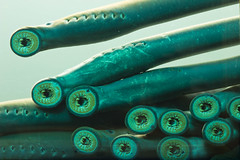![]()
![]()
![]()
Use LEFT and RIGHT arrow keys to navigate between flashcards;
Use UP and DOWN arrow keys to flip the card;
H to show hint;
A reads text to speech;
36 Cards in this Set
- Front
- Back
|
If an animal has segments, bilateral symmetry, pharyngeal clefts, a post-anal tail, and deuterostomic development, it must be a member of the __________ |
Chordates |
|
|
Lampreys have a cartilaginous tube around their notochord; they qualify as ______________ |
Vertabrates, |
|
|
A Lancelet is a ___________ but not a ____________ |
Chordate; vertabrate |
|
|
The formation of you ear can be contributed to what chordate characteristic.... |
Pharyngeal slits or clefts |
|
|
Which chordate characteristic contributes most to suspension-feeding devices in many invertebrate chordates? |
Pharyngeal slits or clefts |
|
|
Gnathastomes |
Jawed vertabrates Examples are sharks, rays, turtles, tuna, pigeons
|
|
|
6 all responses correct |
see front of card |
|
|
7 |
missing hinged jaw in lamprey |
|
|
Chordates derived traits |
Dorsal,Hollow nerve cord Notochord Pharyngeal Slits or Clefts Muscular Post Anal tails |
|
|
Earliest known vertabrates |
Conodonts lived 500 million years ago had dental elements Jawless |
|
|
The gill flap, or operculum, was an important adaptation for fish because it helps with |
maintaining an oxygen supply Water is drawn into the mouth, through the pharynx, and out between the gills by movement of the operculum and contraction of muscles surrounding the gill chambers. |
|
|
The modification of skeletal rods that supported the anterior pharyngeal slit may have led to the development of _________ |
Jaws |
|
|
Oviparous |
Eggs are hatched outside the mothers body |
|
|
Ovoviviparous |
Retain the fertilized egg in the oviduct, born after egg hatches in the uterus |
|
|
Viviparous |
The young develop in the uterus and obtain nourishement from mothers blood through yolk sac |
|
|
The first vertabrates to live on land |
amphibians |
|
|
caecilians |

An amphibian with out legs |
|
|
The development of the amniotic egg allowed _______ to be freed from the water and into a diverse terrestrial enviroment. |
vertabrates |
|
|
Derived Characteristics of tetrapods |
4 limbs Neck that allows separate movement head from body fusion of the pelvic girdle to the back bone -most lack gills ears for detecting airborne sounds |
|
|
Derived Characteristics |
Mammary glands hair high metabolic rate larger brain than vertabrates differentiated teeth |
|
|
Chordates and theyre subphylums |
Lack vertabrae and a back bone -all aquatic organisms Urochordata and cephalochordata |
|
|
Urochordata |

Tunicates like the Sea squirt Sessile as adults and do not have a notochord or dorsal nerve cord |
|
|
Life Cycle of Tunicate |
Once larvae attaches to a host it undergoes a metamorphosis into an adult, a colony will form and release sperm that will lead to reproduction and embryonic development. Once it reaches the larval stage it will seek a new place to attach. |
|
|
Lancelets |

An invertabrate chordate subphylum cephalochordata Example would be Lancelets |
|
|
Craniates |
Vertabrates with a distinct head |
|

Hagfish |
Myxini -Jawless cartilaginous skull reduced vertabrae tooth like formations have slime glands |
|

Lampreys |
7 gill openings petromyzontida cartilaginous segments surround noticard |
|
|
Notochord |
A longitudinal, flexible rod located between digestive tube and nerve cord. Provides skeletal support. |
|
|
Class Chondrichthyes |
Sharks and Rays Cartilages as their endoskelton -Leathery skin |
|
|
Aquatic Gnathosomes categories |
Chondrichthyes ray-finned fish lobe-finned fish
|
|
|
Osteoichthyians |
-animals that have bone as their skelton -all fish except sharks and rays Aquatic osteoichthyians would be bony fish |
|
|
Tiktaalik |

fish with limbs |
|
|
Class amphibia |
-frogs toads salamander -have metamorphosis -formation of lungs -evolution of walking legs -3 chamber heart
|
|
|
Order Eurodella |
"tailed ones" -salamanders |
|
|
Order Apoda |
without legs Caecillians burrowing amphibians
|
|
|
Order anura |
Frogs and toads -lack tails as adults |

